Discover 11 hidden attractions, cool sights, and unusual things to do in Diyarbakir (Turkey). Don't miss out on these must-see attractions: Hazreti Süleyman Mosque, Behram Pasha Mosque, and St. Giragos Armenian Church. Also, be sure to include St. Mary Church in your itinerary.
Below, you can find the list of the most amazing places you should visit in Diyarbakir (Diyarbakir).
Table of Contents
Hazreti Süleyman Mosque
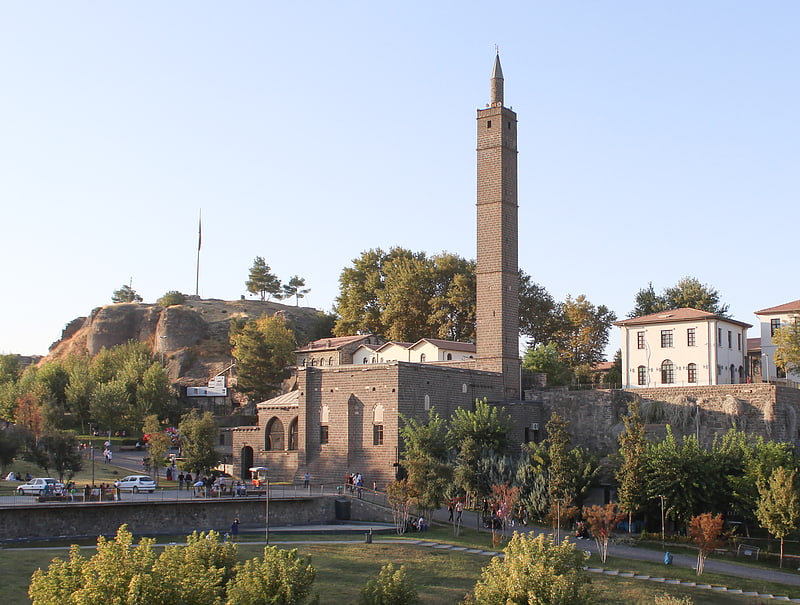
Hazreti Süleyman Mosque is a mosque in Diyarbakır, Turkey.
The mostly ashlar structure was built between 1155 and 1169 by Nisanoğlu Ebul Kasim. The mosque is divided into three sections and has a square-based minaret, which has an inscription dated to 555 AH according to the Islamic calendar. It contains the tombs of Süleyman, son of Khalid ibn al-Walid of the Bekir clan and his followers. The mosque was brought to its current state in 1631 by Silahdar Murtaza Pasha.[1]
Address: Hz. Süleyman Caddesi, Diyarbakir
Behram Pasha Mosque
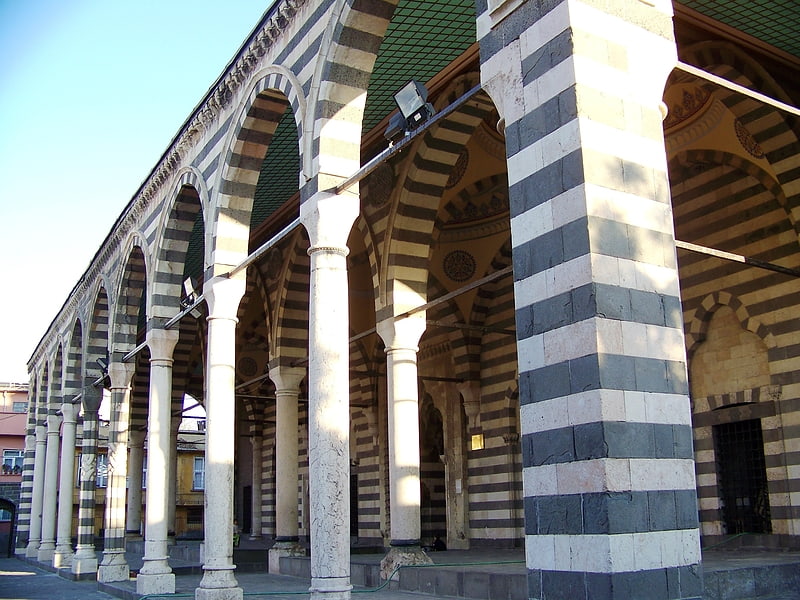
Behrem Pasha Mosque is a 16th-century Ottoman mosque located in the town of Diyarbakır in southeast Turkey. It was commissioned by the Ottoman governor-general Behram Pasha.[2]
Address: Ziya Gokalp Mahallesi, Diyarbakir
St. Giragos Armenian Church

Also known as: Surp Giragos Ermeni Kilisesi
Religious institution in Diyarbakır, Turkey. The Church of St. Giragos is an Armenian Apostolic church in Diyarbakır, Turkey, which was confiscated by the Turkish government in 2016. In the 2000s, it had been renovated in part as a sign of reconciliation with the Christian community. It was reopened on 23 October 2011 as "Turkey’s first church to be revived as a permanent place of worship". It was heavily damaged during armed clashes between the Kurdistan Workers' Party and the Turkish Armed Forces in February 2016, along with the rest of the historic district of Sur, Diyarbakır.
It was seen as one of the largest and most important Armenian churches in the Middle East, with seven altars. It was closed during the Armenian genocide in 1915–1916, and was returned to the local Armenian community in 1960, although due to emigration in the 1970s and 1980s the local Armenian community was much diminished. According to some art historians, the church is the largest in the Middle East. The complex sprawls over 3,200 square meters and includes priests' houses, chapels and a school. The church was seized by the Imperial German Army in 1913 and served as their local headquarters during World War I until 1918, when it was converted into a fabric warehouse.
Ayık also said St. Giragos had several unique architectural features. "Churches normally have one altar but St. Giragos has seven altars. Its original roof was covered with the earth from around the region. We will do it again. The earth has been stripped of seeds to prevent the growth of plants. It should also be vented regularly, every year. The chairman, whose family is originally from the southeastern province, said the church was handed over to the foundation by the General Directorate of Foundations in the 1950s and continued providing church services until the early 1990s." After the founding of the Turkish Republic in 1923, it was used as a state warehouse for canvas and fabrics, and then, despite sporadic efforts by the dwindling Armenian community in Diyarbakır, it had been left to deteriorate and decay until 2009, when a few Armenians born in Diyarbakır but living in Istanbul, formed a Foundation Board under the auspices of the Armenian Istanbul Patriarchate, with the goal of reconstructing the church, as well as to start a legal process to reclaim title to the significant land holdings originally belonging to the church.
The church attracts hundreds of people per day; according to Gafur Turkay of the Surp Giragos Foundation, "Many of them are Islamised Armenians like me."
On 26 March 2016 the Turkish government confiscated St. Giragos, under Article 27 of the Expropriation Law. Neighbouring Syriac, Chaldean and Protestant churches were also expropriated as part of the same decision, which comprised the expropriation of some 6,300 plots of land in Diyarbakir's Sur (walled town) district, about 80% of the property in that district. The Diyarbakir Bar Association released a statement saying "this decision violates the property right and is also against Turkish Constitutional Law, Expropriation Law, and European Convention on Human Rights".[3]
St. Mary Church
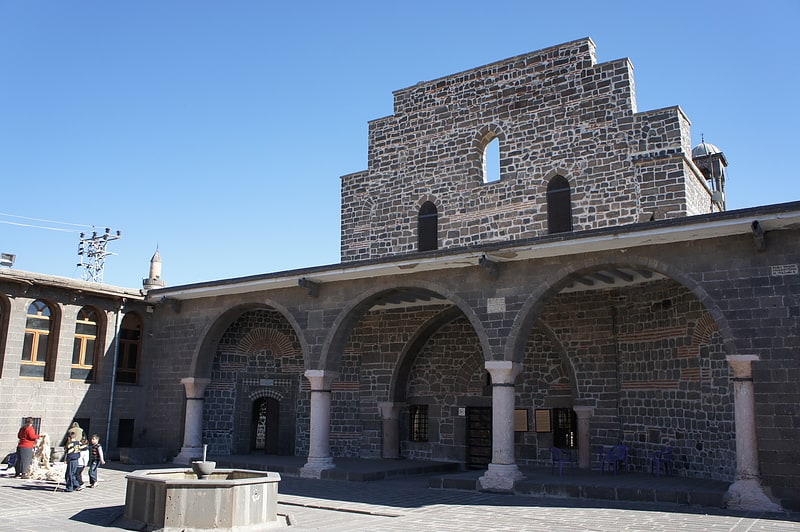
Church in Diyarbakır, Turkey. St. Mary Church, is a Syriac Orthodox church in Diyarbakir. It is under the jurisdiction of the Syriac Archdiocese of Mardin, headed by Metropolitan Mor Filüksinos Saliba Özmen. The church was first constructed as a pagan temple in the 1st century BC, and the current construction dates back to the 3rd century. The church has been restored many times, and is still in use as a place of worship today. The church is open to visitors for a 5 lira entrance fee.[4]
Address: Turistik Caddesi Ana Sokak No:35 SUR, Diyarbakir
Sheikh Matar Mosque
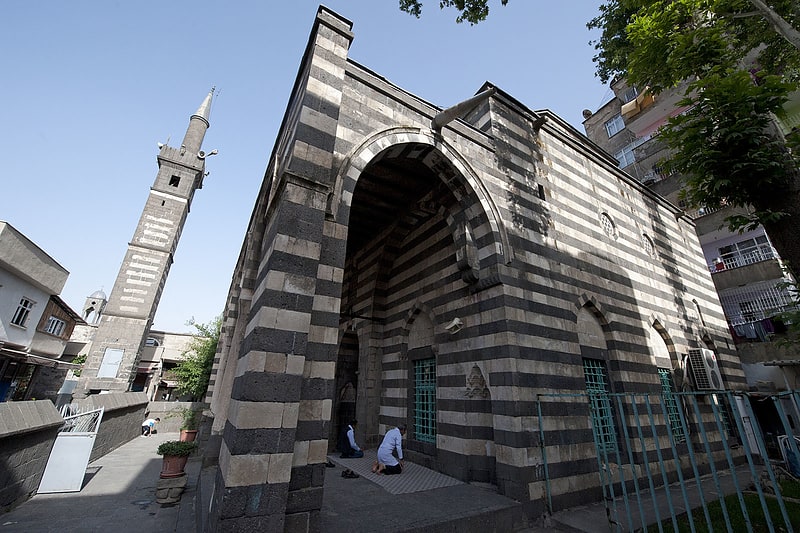
Also known as: Şeyh Mutahhar Camii
Mosque in Diyarbakır, Turkey. Sheikh Matar Mosque or Sheikh Mutahhar Mosque is a historical mosque in Diyarbakır, Turkey, best known for its unique minaret based on four columns, dubbed the Four-legged Minaret.
The mosque is situated in the Yenikapı Street of Savaş neighborhood at Diyarbakır's walled historical district of Sur. The mosque is named after Sheikh Matar (Mutahhar) as it is believed that the mosque's estate covering 600 m2 (6,500 sq ft) contains the grave of the sheikh.
According to an inscription attached at the minaret, the mosque was built by Hajji Hüseyin, son of Hajji Ömer during the reign of Ag Qoyunlu Sultan Kasım Han in 1500. Locally, it is also known as the "Kasım Padishah Mosque". It is owned by the General Directorate of Foundations.
The mosque is a single-dome, quadratic-plan building having stone masonry walls alternating with brick. There are three windows at each side, and two in the front and backside each, all arched. The two windows on the qibla wall are closed with masonry. It has a covered area of 221 m2 (2,380 sq ft), and can hold up to 500 worshipers.
The stand-alone minaret in the form of a quadratic prism is erected on four massive stone columns. In the "Diyarbakır Salnâmeleri" (Yearbooks of Diyarbakır), it is recorded that the tower was built in 906 as a stable and high structure, and was converted into a minaret with the construction of the mosque next to it after the conquest of the region by Islamic people. Today, local people construe that the four columns at the minaret's base symbolize the four main denominations of Sunni Islam, namely Hanafi, Hanbali, Maliki and Shafi'i.
The mosque underwent a restoration in 1960 through the General Directorate of Foundations.[5]
Cahit Sıtkı Tarancı Museum
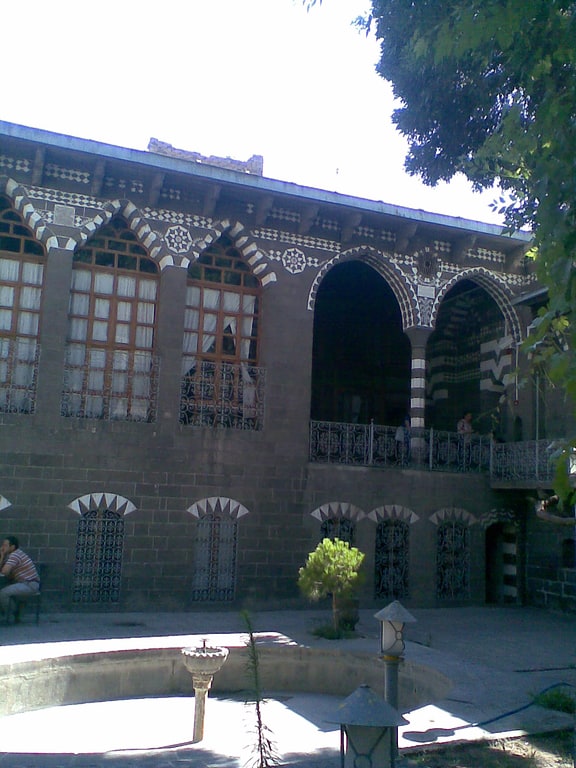
Also known as: Cahit Sıtkı Tarancı Müzesi
Museum in Diyarbakır, Turkey. Cahit Sıtkı Tarancı Museum is a historic house and museum dedicated to Cahit Sıtkı Tarancı in Diyarbakır, Turkey.
The museum is located in the historic Sur district of Diyarbakır, close to the Grand Mosque.
The museum building was the house where Cahit Sıtkı Tarancı (1910–1956), a well known poet, was born in. The building was constructed in 1733. It is a two-story house. The construction material is basalt stone. The building is composed of four symmetrical sections around a square courtyard. These parts are traditional living quarters in different seasons; north in summer, east in spring, south in winter and west in autumn. There are 14 rooms in the building. Cahit Sıtkı Tarancı was born in the biggest room, so called "başoda" (literally: main room), in the summer section.
In 1973, the house was purchased by the Ministry of Culture, and it was opened to visits on 29 October 1973, the 50th anniversary of the proclamation of the Republic. In 2003 it was restored.
The 152 exhibited items are the personal belongings of Cahit Sıtkı Tarancı and his family members.[6]
Address: Cami Kebir Mah. Muze Sok. No:3 Surici, Sur, Diyarbakir
Diyarbakır Grand Mosque

Also known as: Diyarbakır Ulu Camii
Mosque in Diyarbakır, Turkey. The Great Mosque of Diyarbakır was built by the Seljuk Sultan Malik-Shah I over an older mosque, and is considered by Muslim scholars to be the fifth holiest site in Islam after the Great Mosque of Damascus, which it is stylised after. It can accommodate up to 5,000 worshippers and hosts four different Islamic traditions.[7]
Address: Gazi Cd, Diyarbakir
Diyarbakır Fortress
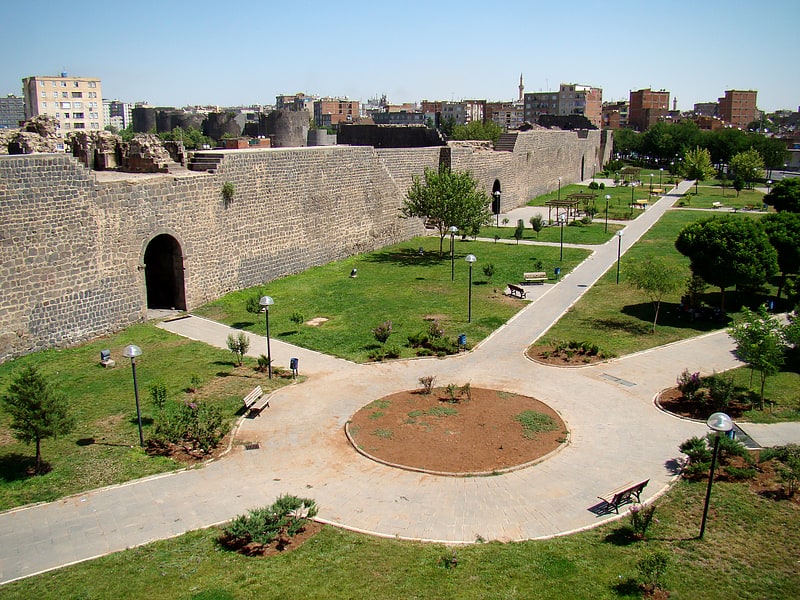
Also known as: Diyarbakır Kalesi
Fortress in Diyarbakır, Turkey. Diyarbakır Fortress, is a historical fortress in Sur, Diyarbakır, Turkey. It consists of an inner fortress and an outer fortress.
The main gates of the fortress are: Dağ (Mountain) Gate, Urfa Gate, Mardin Gate, and Yeni (New) Gate. The walls come from the old Roman city of Amida and were constructed in their present form in the mid-fourth century AD by the emperor Constantius II. According to Armenian historian Movses Khorenatsi, the fortifications and powerful walls of Amid-Diyarbakir were built in the middle of 6th century BC under King Tigranes of and during the Yervanduni (Orontid dynasty).They are the widest and longest complete defensive walls in the world after only the Great Wall of China (the Theodosian Walls for example are longer in length, but are not continuous)
UNESCO added the building to their tentative list on 2000, and listed it as a World Heritage Site in 2015 along with Hevsel Gardens.[8]
Dicle Bridge
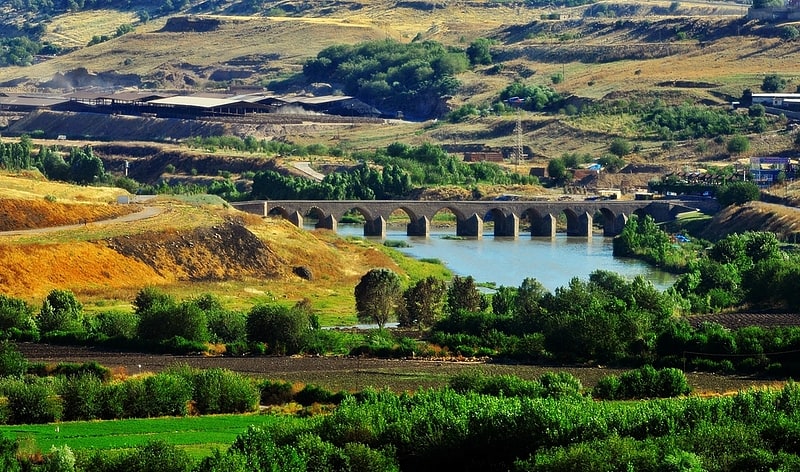
Also known as: Dicle Köprüsü
Bridge. The Dicle Bridge is a historic bridge in Diyarbakır over the river Tigris in southeastern Turkey. Completed in 1065, it numbers ten arches with a total length of 178 m. Hence, it is locally called also "On Gözlü Köprü" / "Pira Dehderî". Its another name is the Silvan Bridge due to its position being on the road to Silvan.
The bridge was commissioned by Nizam al-Din and Muyyid al-Dawla during the Kurdish dynasty, Marwanids era (990–1085) in Diyarbakır, and was built by architect Yusuf son of Ubeyd son of Sandjar in 1065, as stated in two lines of Kufic script in the inscription mounted on the southern facade of the bridge.
The bridge is situated south of the city, 3 km (1.9 mi) outside of Mardinkapı/Deriyê Mêrdînê (literally: Mardin Gate). Its location is the nearest to the city considered the bends and the course of the river as well as the rate of water flow. Built with black volcanic stones, the bridge is 178 m (584 ft) long and 5.60 m (18.4 ft) wide, varying at some places on it. Longest span of the ten arches measures 14.70 m (48.2 ft).
Due to its historic characteristic, motorized traffic over the bridge suspended after the construction of the Marwanids Bridge (Turkish: Mervaniler Köprüsü; Kurdish: Pira Merwaniyan), or as initially named Bağıvar Bridge, in November 2009. The new bridge was built about 1 km (0.62 mi) south of Dicle Bridge, far enough not to spoil the landscape view of the old bridge.[9]
Hasan Paşa Hanı

Museum, Flea market, Shopping, Historical place
Address: Gazi Cad., 21100 Sur
Diyarbakır Archaeological Museum
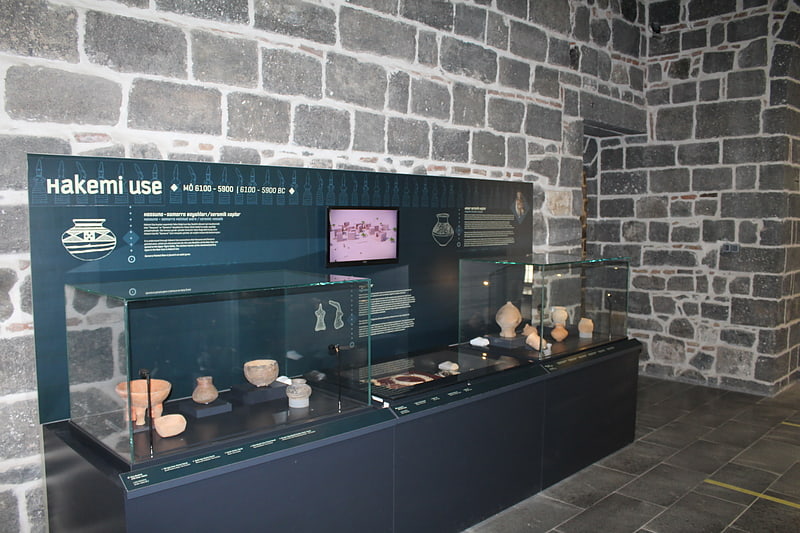
Museum. Diyarbakır Archaeological Museum is an archaeological museum in Diyarbakır, Turkey.[10]